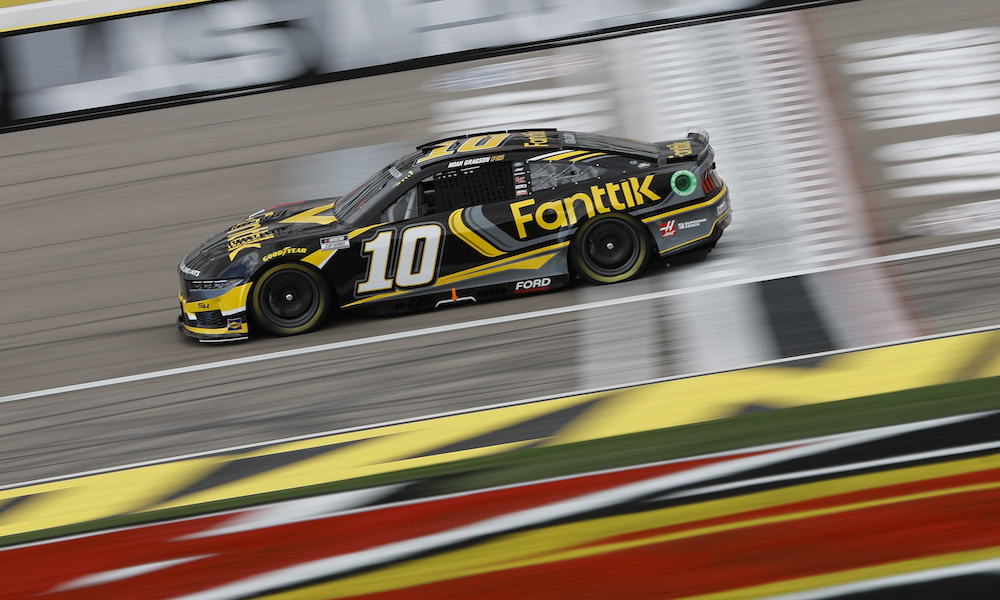Noah Gragson expected this season to be a test of patience as he returned to the NASCAR Cup Series and integrated into the Stewart-Haas Racing camp.
On Sunday in Las Vegas, Gragson made strides towards doing that on his way to finishing sixth. Gragson came from the rear of the field, 30th position, to a career-best finish on a non-superspeedway racetrack. Gragson’s No. 10 Ford Mustang Dark Horse was the most consistent and fastest Stewart-Haas car from its practice run through the race.
“The amount of pace we had in practice allowed me to be patient,” Gragson said. “The amount of pace we had in the race allowed me to be patient because I knew, ‘Hey, if I’m in a position to make a pass and if I don’t get that pass complete, I know there’s going to be another opportunity.’ Where last year, we might not have had that pace and I felt like I had to attack that one time – like I only had one opportunity, and most of the time, I’d mess it up, and I was driving over my head. When you have a fast car, it allows you to be more patient.”
[lawrence-auto-related count=3 category=1428]
There are a few reasons for Gragson’s patience being top of mind this season. Regarding experience, he is still relatively new to the Cup Series, with less than 50 career starts. What was supposed to be his first full season, 2023, ended prematurely when Gragson was suspended and subsequently lost his ride.
Gragson is now in a new environment at Stewart-Haas. It’s a new team and a new car. It’s also a different manufacturer than Gragson has previously driven. And when it comes to on-track performance, Gragson’s patience is bound to be tested as Stewart-Haas Racing continues its fight back toward the front of the garage.
It won’t come as easy as Gragson made it look when driving an Xfinity Series car. Even with all the confidence in the world, he tried to carry the Cup Series car last year and asked for more than it was capable of, which often put himself in a bad situation.
“I feel the most comfortable I’ve felt and the most patient I’ve felt this year just because (the cars) do have speed and I know there’s plenty of opportunities to make those passes,” Gragson continued. “‘Hey, if I don’t get them this corner, let me re-try and mount a run, and I’ll have an opportunity the next lap.’ That definitely gives me a lot of confidence as a driver, and I feel like I have that this year.”
The comfort level behind the wheel has been a pleasant surprise for Gragson.
“I think if you would have asked me that before this season started, I would have said no, I don’t feel comfortable in a Next Gen car at all,” he said. “But all this year, and this past weekend especially, because that was our true first real race other than a superspeedway, I feel really comfortable. It’s the most comfortable I’ve ever felt by a long shot inside the race car, and I told our crew that after the race. It’s like, ‘Man, I feel like I can feel every corner of this race car.’
“I could feel how the tires were loading, where I couldn’t feel it last year. It was evil to drive. That allows me to be a lot calmer and a lot more patient and allows me to give better feedback, too, because you’re only worrying about one or two things.”
Gragson has 42 starts in the Cup Series – in the Next Gen car. But they’ve come for multiple teams. In 2022, Gragson ran a Chevrolet for Beard Motorsports, Kaulig Racing and Hendrick Motorsports. Last year, Gragson was in a Chevrolet for Legacy Motor Club.
Stewart-Haas Racing’s car is the first Ford that Gragson has driven. Sunday in Las Vegas was his second top-10 finish in three starts for the organization.
“We were pretty close the way we unloaded this past weekend,” Gragson said. “‘Hey, I’m a little loose here. I’m a little tight here,’ and there are two or three things that you’re trying to fix in practice, where last year I would get out of the car and I’m like, ‘Man, I don’t even know where to start because there’s like 10 different things going on.’ It was hard to pick the priority to fix because there were nine or 10 different issues throughout a lap where you’re like, ‘Man, it’s hitting the left rear too hard, but then I’m getting loose. I’m tight here.’
“This year, you only have like two or three things – at least we saw at Vegas – that it allows you to really pick the priority and focus on, ‘Hey, we’re either too loose on entry, or we’re a little tight on exit.’ What do we want to fix? Instead of 10 different issues, which was really challenging last year because I didn’t know what to prioritize. I don’t want to say it’s easier, but it’s simpler, if anything, so far this year.”
